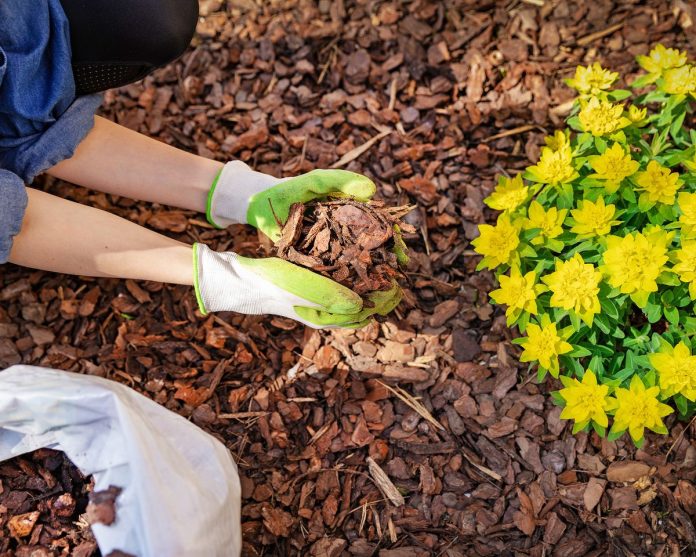[ad_1]
Mulch is a layer of material added to the surface of soil in the garden, typically in beds and at the base of trees. There are so many benefits of using mulch in the garden. It helps soil retain water and nutrients, reduces soil erosion, suppresses weeds, and protects plant roots from extreme hot and cold temperatures.
New gardeners may understand the importance of mulching but not necessarily how to do it correctly. Yet, when done incorrectly, garden mulch problems can occur and harm the soil and plants.
Avoid these common mulching mistakes that can cause more damage than good.
1. Using Too Much Mulch
While mulch provides several benefits, it’s possible to have too much of a good thing. Excess mulch can trap excess water at the roots of plants. It can also compress and compact the soil, reducing oxygen and water flow.
The good news about using too much mulch is that it’s easy to fix. Simply rake off enough mulch to leave two to three inches in place. Use the excess mulch in other beds or save for filling in patches as needed.
(Image credit: Getty Images)
2. Using Too Little Mulch
Likewise, not having enough mulch defeats the purpose of mulching. You won’t get the benefits of water retention, weed suppression, or plant protection if you don’t apply enough mulch. Aim for two to three inches.
If the mulch layer is too thin, simply add more. Keep some extra mulch on hand for patching areas that have thinned due to wind, raking, or digging animals.
3. Piling Mulch Too High Around Trees
Some people pile mulch up around trees in what is known as a mulch volcano. This cone of mulch might look attractive, but it actually harms the tree. The thick layer of mulch up against the base of a tree restricts airflow and can suffocate roots. Excess mulch here also invites pests and moisture that can lead to disease and rot.
As with other mulched areas, keep the layer around any trees or shrubs two to three inches thick. You can even leave a thin ring around the trunk mulch-free. If you have already created a mulch volcano, remove some of the material to let the trunk breathe and dry out.
(Image credit: Getty Images)
4. Not Weeding Before Mulching
One of the biggest benefits of mulching is keeping weeds at bay. It’s not a perfect solution, but a good layer of mulch reduces the number and size of weeds, which compete with your plants for water and nutrients.
Don’t assume that a pile of mulch will kill existing weeds – especially those that are large or more established. Weeds are persistent and will find a way up to the light. Always pull weeds before applying mulch.
If it’s too late, you’ll have to dig through the mulch to get weeds out by the roots.
5. Using The Wrong Mulch
The number of different types of mulch to choose from can be overwhelming if you’re new to the practice. Each type has its uses and benefits. Select the right mulch for the job.
Bark and wood chip mulches are good choices for flower beds and around trees, while grass clippings, leaves, and hay are best for vegetable beds.
Also, avoid colored mulches made with wood or bark treated with chemicals and dyes. Natural mulch is always the best option. If you learn after the fact that you used the wrong mulch, consider taking the time to remove it and start over again. Your plants will thank you.
(Image credit: Getty Images)
6. Mulching Too Early In Spring
It’s tempting to get outside at the first sign of better weather in spring and start working in the garden. But resist the urge to mulch right away. Give the soil a chance to warm up before adding mulch.
Mulching too early keeps the soil cold, making it more difficult for seedlings to grow and emerge. Wait until mid- or even late spring to mulch.
Use the time to thoroughly weed beds and rake out old mulch.
7. Not Raking Old Mulch
Laying down mulch is not a one-and-done garden chore. Over time, mulch breaks down or gets removed and dispersed by rain, wind, and other forces. It thins and needs replacing regularly.
When replacing mulch, don’t simply lay it over old mulch – take the time to rake the old material. Reusing old mulch is an option, but you need to mix it in with the new material.
Leaving the old mulch in place and piling more on top of it contributes to compaction of the soil, which ultimately suffocates plant roots and reduces water absorption.
You don’t necessarily need to remove the old mulch but you should rake it and fluff up the soil to reduce compaction.
Melanie Griffiths
Melanie has worked in homes and gardens media for two decades. Having previously served as Editor on Period Living magazine, and worked on Homes & Gardens, Gardening Etc, Real Homes, and Homebuilding & Renovating.
An experienced gardener, Melanie has spent the last few years transforming her own yard. She is also a keen home grower, having experimented with pretty much every type of vegetable at some point.
[ad_2]

